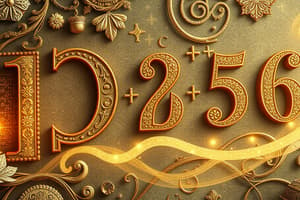Podcast
Questions and Answers
What does each digit represent in a decimal notation?
What does each digit represent in a decimal notation?
A specific power of ten
If a digit is in the hundredths place, what is it multiplied by?
If a digit is in the hundredths place, what is it multiplied by?
0.01
How do you round a decimal number when the digit to the right of the desired place is 5 or greater?
How do you round a decimal number when the digit to the right of the desired place is 5 or greater?
Round up
What is the result of rounding 3.1415 to 2 decimal places?
What is the result of rounding 3.1415 to 2 decimal places?
How can decimal fractions be converted to whole numbers?
How can decimal fractions be converted to whole numbers?
What is the result of adding 2.3 and 5.7 after rounding to the nearest tenth?
What is the result of adding 2.3 and 5.7 after rounding to the nearest tenth?
When multiplying decimals, what is the rule for moving the decimal point in the result?
When multiplying decimals, what is the rule for moving the decimal point in the result?
How many decimal places are present in the result when dividing 3.6 by 1.2?
How many decimal places are present in the result when dividing 3.6 by 1.2?
Explain how to convert a decimal to a fraction.
Explain how to convert a decimal to a fraction.
What is the result when rounding 3.125 to the nearest whole number?
What is the result when rounding 3.125 to the nearest whole number?
Flashcards are hidden until you start studying
Study Notes
Decimals and Their Place Value: A Guide to Precise Quantities
Decimals are an essential part of our daily lives, allowing us to accurately represent fractional amounts, measurements, and prices. To fully understand decimals, it's essential to grasp their place value system.
Place Value and Decimals
In decimal notation, each digit represents a specific power of ten, starting from the rightmost digit, which is the ones place, worth 1. The next place to the left is the tenths place, multiplied by 0.1, followed by the hundredths place, multiplied by 0.01, and so on.
For example, in the decimal number 12.345,
- The 5 is in the hundredths place, multiplied by 0.01, resulting in 0.05.
- The 4 is in the thousandths place, multiplied by 0.001, resulting in 0.004.
Rounding Decimals
Rounding decimals is a vital skill for practical applications. You can round to specific decimal places as follows:
- Round up if the number immediately to the right of the desired place is 5 or greater.
- Round down if the number immediately to the right of the desired place is 4 or less.
For example, rounding 3.1415 to 2 decimal places, the number 1 is less than 5, so we round down to 3.14.
Decimal Fractions and Whole Numbers
Decimal fractions can be converted to whole numbers by dropping the decimal point and the digits to the right of it. Conversely, decimals can be created from whole numbers by moving the decimal point to the left. For example:
- 5.3 becomes 53 when rounding down to the nearest whole number.
- 3.125 is equivalent to 3 when moving the decimal point one place to the left.
Addition and Subtraction of Decimals
When adding or subtracting decimals, you need to align the decimal points and perform standard addition or subtraction, then round the result if necessary. For example:
- Adding 2.3 and 5.7 gives 8, with a remainder of 0.1, so we round up to 8.1.
- Subtracting 3.12 from 8.68 gives 5.56, rounded to two decimal places.
Multiplication of Decimals
Multiplication of decimals follows the typical rules of multiplication, with one important note: You must move the decimal point in the result the same number of places as in the factors being multiplied. For example:
- Multiplying 0.3 by 1.4 gives 0.42, with one decimal place in the result.
Division of Decimals
Dividing decimals involves moving the decimal point in the divisor (the number being divided) the same number of places as in the dividend (the number being divided by). The result will have the same number of decimal places as the dividend.
For example:
- Dividing 3.6 by 1.2 gives 3, with two decimal places in the result (0.25).
Converting to Fractions and Percents
Decimals can be converted to fractions by deleting the decimal point and the digits to the right and placing a fraction bar over the remaining digits. For example, 0.333 can be converted to the fraction 3/10.
Decimals can also be converted to percents by multiplying by 100. For example, 0.33 can be converted to 33%.
In summary, decimals are an essential part of mathematics, enabling us to represent fractional amounts and measurements. By understanding their place value system, we can perform operations with decimals, convert them to fractions and percents, and use them in practical applications.
Studying That Suits You
Use AI to generate personalized quizzes and flashcards to suit your learning preferences.




